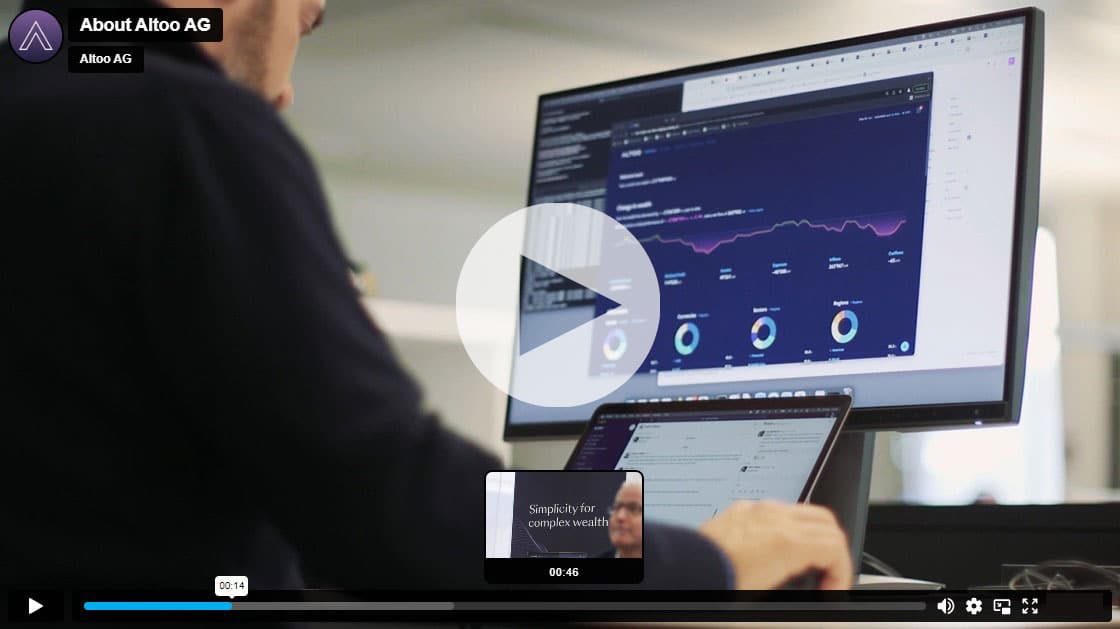In a hybrid model, a portion of the investment process is outsourced. It is favored by Family Offices managing a smaller investment team.
Two types of hybrid models are common:
Focusing on high-level execution of the investment strategy
The internal Family Office (FO) team works on high-level execution of the investment strategy. This includes portfolio construction, asset allocation, overall risk management, and reporting to the investment committee. The steps of the FO team are helped by outside investment managers and experts, mostly in the areas of choosing managers and keeping an eye on them.
Usually, a small team of one to three people sets the asset allocation framework, target risk, and liquidity levels. The management of each asset class is outsourced to the so-called Outsourced Chief Investment Officer (OCIO).
Wealth Aggregation: Simple, Dynamic, and Secure Beyond Compare. Discover the Altoo Wealth Platform!
Managing one or several investment areas
The internal FO team directly manages one or several investment areas. Other specific asset-class mandates are being delegated to external advisers. This outsourcing means clearly dividing the asset classes managed in-house from those managed externally.
Family knowledge vs. outsourcing
The investment strategy and resulting internal setup are merely two important decisions that Family Offices face. The manner in which wealthy families manage their investment portfolios will remain as diverse as the families themselves.
It is very natural for the family to keep a hands-on approach. Family health has often been created by the family´s deep knowledge of a specific industry or sector. Individual family members do like to maintain expertise and passion for this work.
For example, the family internally manages all direct private equity investments and only rarely extends their work to other asset classes. Some Family Offices therefore opt to leave the management of these unfamiliar asset classes to outside firms rather than hire in-house staff.
Expensive internal team
The benefits of building an in-house investment team include cost-effectiveness for the largest FO and management control. Still, building an internal team can be challenging but impractical. An investment strategy that includes alternative investments requires a minimum of two or three people to cover each asset class.
The cost is one of the main reasons why this type has become popular. Building a business team in-house can give you more control and flexibility, but it can also be hard on your finances, especially for smaller family offices.
Even though it costs a lot to put together a full multi-asset-class in-house team, it is a good choice for family offices with more than USD 2 billion in assets. This financial limit shows how important it is to think carefully about what the best method to wealth management is.
It means an enormous investment. From a financial perspective, a full multiasset-class in-house team would start being viable for an investment portfolio of USD 2 billion in assets and above.
To take the best of both worlds
In the ever-changing world of wealth management for family offices today, the question of whether to build an in-house investment team or outsource the whole process of handling investments is a big one. Many family offices are finding that using both in-house and outside experts in a combined plan is a great way to get ahead.
This method lets family offices take advantage of the best of both worlds. They can use their deep industry knowledge and passion while also taking advantage of the specific skills and resources that experts from outside the family office can offer.
In a rapidly changing financial world where diversification is key, this hybrid model not only maximizes cost-effectiveness but also ensures the adaptability and agility needed to navigate the complex waters of modern wealth management.
As long as families keep looking for unique solutions that work for them, the hybrid model is likely to stay a popular and flexible approach in the field of family office wealth management.









